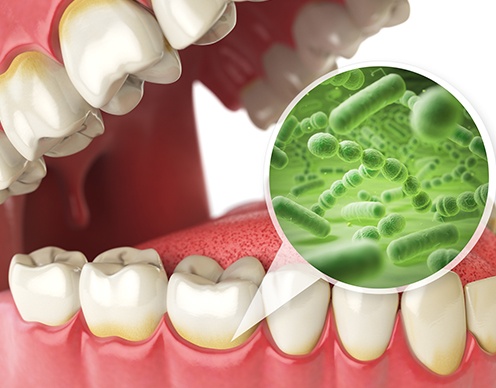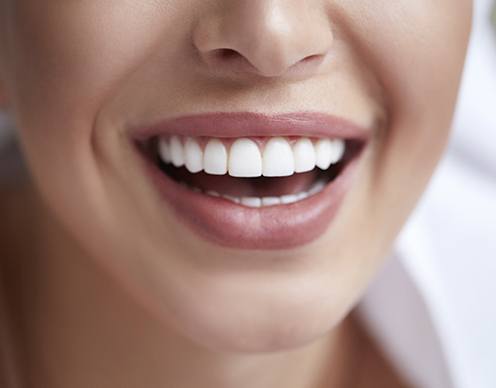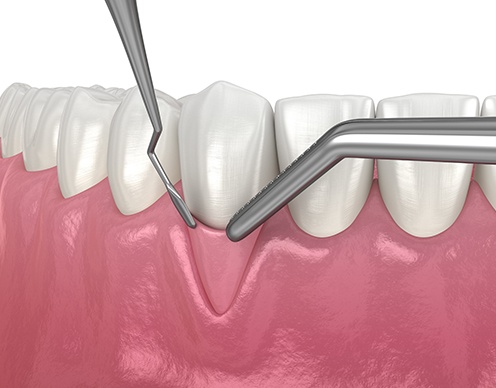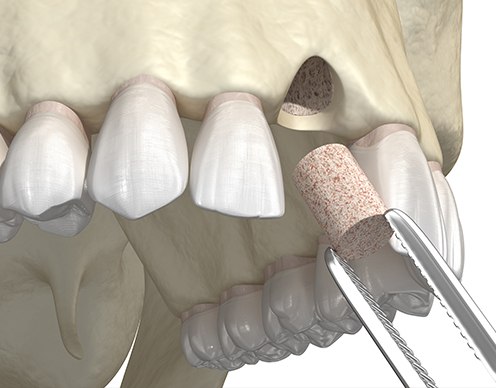Periodontal Disease Treatment – Randolph, NJ
Keeping Your Smile
Safe from Infection
The most common disease in the United States is not what you may think. Heart disease, stroke, or cancer come to mind, but actually gum disease is the single most prevalent disease in America. In fact, it affects more people than heart disease, stroke, Alzheimer's, and cancer combined. About 80% of the population has some form of gum disease, also known as periodontal disease, periodontitis (an advanced stage), and gingivitis (a mild stage).
Surprisingly, the general public still does not know the severe and deadly complications associated with gum disease. By treating this disease and getting it under control, you can add years to your life and life to your years. We at Randolph Dental Care take this matter very seriously. That's why we use a revolutionary antibiotic known as Arestin to help patients. Arestin kills bacteria over time, providing you with protection even after your visit is over. We can also supply you with materials to use at home, because we don't want to give you the fish, we want to teach you how to fish! Heart disease, diabetes, and cancer are just three of the diseases linked with gum disease. Keep reading to learn more about your options for periodontal disease treatment in Randolph, NJ.
Why Choose Randolph Dental Care for Periodontal Disease Treatment?
- Advanced Dental
Laser Technology - Dentist with Decades
of Experience - Comfortable,
State-of-the-Art Dental Office
What is
Gum Disease?

Gum disease is an infection of the gums and bone that support teeth that usually starts early in life. The disease progresses as a person ages. It all starts when plaque hardens into tartar (also called calculus) below the gum line. This irritates vulnerable soft tissues, allowing the infection to set in. Combined with decaying food particles lodged between teeth and bacteria emitted by plaque, the infection can spread quickly. Symptoms are so mild in the early phase (red, tender, swollen gums and bleeding when brushing) that many patients don't recognize them.
As the condition progresses, gums recede (move away from) the teeth, forming pockets of bacteria. The bacteria can destroy gum tissue and bone, causing tooth and bone loss.
Gum Disease Treatment

Once gum disease sets in, we can often treat it with non-surgical therapy including:
- Scaling – to remove hardened plaque from below the gum line
- Root Planing – to reduce rough areas laden with bacterial toxins or the roots of teeth
- Arestin – to kill the bacteria causing your gum disease and provide long-lasting protection for your smile.
- Laser Bacterial Reduction
Expect to attend more frequent hygiene visits so that Dr. Glen & Zachary Goldstein or their hygienist can monitor your condition and make sure that recovery is on track. Since there is no cure for periodontal disease, you will need to be seen a minimum of four times per year for the rest of your life to maintain this problem.
Help for
Bad Breath

It's estimated that 25 million Americans suffer from chronic bad breath. If you hesitate to speak to others or fear intimate conversations with loved ones, then you know that your dentist is not the only one who knows your secret. That’s the bad news – the good news is that bad breath can be treated!
Most bad breath is caused by VSCs (Volatile Sulfur Compounds). These compounds are released by bacteria in the mouth as they metabolize what we eat, causing the odor known as bad breath. The more bacteria you have, the more intense the odor can be. If your mouth is unclean and therefore unhygienic, the problem worsens. We have been successful at treating halitosis (bad breath) for over 25 years! Our specific homecare regimen does not just cover up the problem – it neutralizes the odor. Isn't it time you started enjoying conversations again? Visit Drs. Glen and Zachary Goldstein for your halitosis analysis.
Gum Disease
and Diabetes

The link between gum disease and diabetes has been debated for some time. Researchers agree that the link exists, but the relationship is unclear. Are patients with diabetes more susceptible to gum disease, or is it the other way around? In recognition of National Diabetes Month, the International Diabetes Federation (IDF) has released some new guidelines on oral health for people with diabetes.
Learn More About Gum Disease and Diabetes
Gum Grafting
& Reduction

Gum tissue can recede from teeth because of gum disease, a bad bite, brushing too hard, or hereditary proclivity for gum recession. Strong gum tissue keeps teeth solidly anchored and looks attractive. To subsidize recessed gum tissue, a gum graft may be required. Existing gum tissue will integrate with the graft placed over exposed teeth roots. The new gum tissue will offer better support for teeth.
On the other end of the spectrum, patients with overgrown gum tissue may require gum reduction. Removing excess gum tissue can improve a person’s appearance by uncovering tooth structure, which makes teeth appear longer and larger. In some cases, gum reduction is required prior to crown placement. This procedure is called crown lengthening.
Bone Grafting

When one or more natural teeth are lost over a long span of time, a common consequence is that the bone starts to deteriorate. This causes problems later on when patients are ready to replace the missing dental structure with dental implants and there is not enough tooth-supporting bone left in the jaw. Thankfully, our team can help with well-placed bone grafts. All we need to do is apply the grafting material through a small incision in the gumline, where it will be absorbed by the body. The final result is a much sturdier foundation for your revitalized smile!









